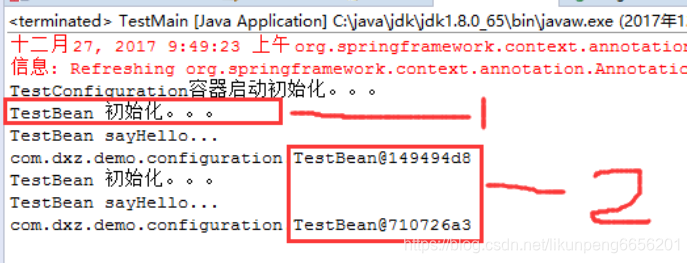@Configuration
從Spring3.0,@Configuration用于定義配置類,可替換xml配置文件,被注解的類內部包含有一個或多個被@Bean注解的方法,這些方法將會被AnnotationConfigApplicationContext或AnnotationConfigWebApplicationContext類進行掃描,并用于構建bean定義,初始化Spring容器。
注意:@Configuration注解的配置類有如下要求:
@Configuration不可以是final類型;
@Configuration不可以是匿名類;
嵌套的configuration必須是靜態類。
一、用@Configuration加載spring
1.1、@Configuration配置spring并啟動spring容器
1.2、@Configuration啟動容器+@Bean注冊Bean
1.3、@Configuration啟動容器+@Component注冊Bean
1.4、使用 AnnotationConfigApplicationContext 注冊 AppContext 類的兩種方法
1.5、配置Web應用程序(web.xml中配置AnnotationConfigApplicationContext)
二、組合多個配置類
2.1、在@configuration中引入spring的xml配置文件
2.2、在@configuration中引入其它注解配置
2.3、@configuration嵌套(嵌套的Configuration必須是靜態類)
三、@EnableXXX注解
四、@Profile邏輯組配置
五、使用外部變量
一、@Configuation加載Spring方法
1.1、@Configuration配置spring并啟動spring容器
@Configuration標注在類上,相當于把該類作為spring的xml配置文件中的,作用為:配置spring容器(應用上下文)
package com.dxz.demo.configuration;import org.springframework.context.annotation.Configuration;@Configuration
public class TestConfiguration {public TestConfiguration() {System.out.println("TestConfiguration容器啟動初始化。。。");}
}
<?xml version="1.0" encoding="UTF-8"?>
<beans xmlns="http://www.springframework.org/schema/beans" xmlns:xsi="http://www.w3.org/2001/XMLSchema-instance"xmlns:context="http://www.springframework.org/schema/context" xmlns:jdbc="http://www.springframework.org/schema/jdbc" xmlns:jee="http://www.springframework.org/schema/jee" xmlns:tx="http://www.springframework.org/schema/tx"xmlns:util="http://www.springframework.org/schema/util" xmlns:task="http://www.springframework.org/schema/task" xsi:schemaLocation="http://www.springframework.org/schema/beans http://www.springframework.org/schema/beans/spring-beans-4.0.xsdhttp://www.springframework.org/schema/context http://www.springframework.org/schema/context/spring-context-4.0.xsdhttp://www.springframework.org/schema/jdbc http://www.springframework.org/schema/jdbc/spring-jdbc-4.0.xsdhttp://www.springframework.org/schema/jee http://www.springframework.org/schema/jee/spring-jee-4.0.xsdhttp://www.springframework.org/schema/tx http://www.springframework.org/schema/tx/spring-tx-4.0.xsdhttp://www.springframework.org/schema/util http://www.springframework.org/schema/util/spring-util-4.0.xsdhttp://www.springframework.org/schema/task http://www.springframework.org/schema/task/spring-task-4.0.xsd" default-lazy-init="false"></beans>
package com.dxz.demo.configuration;import org.springframework.context.ApplicationContext;
import org.springframework.context.annotation.AnnotationConfigApplicationContext;public class TestMain {public static void main(String[] args) {// @Configuration注解的spring容器加載方式,用AnnotationConfigApplicationContext替換ClassPathXmlApplicationContextApplicationContext context = new AnnotationConfigApplicationContext(TestConfiguration.class);// 如果加載spring-context.xml文件:// ApplicationContext context = new// ClassPathXmlApplicationContext("spring-context.xml");}
}

1.2、@Configuration啟動容器+@Bean注冊Bean,@Bean下管理bean的生命周期
@Bean標注在方法上(返回某個實例的方法),等價于spring的xml配置文件中的,作用為:注冊bean對象
bean類:
package com.dxz.demo.configuration;public class TestBean {private String username;private String url;private String password;public void sayHello() {System.out.println("TestBean sayHello...");}public String toString() {return "username:" + this.username + ",url:" + this.url + ",password:" + this.password;}public void start() {System.out.println("TestBean 初始化。。。");}public void cleanUp() {System.out.println("TestBean 銷毀。。。");}
}
package com.dxz.demo.configuration;import org.springframework.context.annotation.Bean;
import org.springframework.context.annotation.Configuration;
import org.springframework.context.annotation.Scope;@Configuration
public class TestConfiguration {public TestConfiguration() {System.out.println("TestConfiguration容器啟動初始化。。。");}// @Bean注解注冊bean,同時可以指定初始化和銷毀方法// @Bean(name="testBean",initMethod="start",destroyMethod="cleanUp")@Bean@Scope("prototype")public TestBean testBean() {return new TestBean();}
}
package com.dxz.demo.configuration;import org.springframework.context.ApplicationContext;
import org.springframework.context.annotation.AnnotationConfigApplicationContext;public class TestMain {public static void main(String[] args) {// @Configuration注解的spring容器加載方式,用AnnotationConfigApplicationContext替換ClassPathXmlApplicationContextApplicationContext context = new AnnotationConfigApplicationContext(TestConfiguration.class);// 如果加載spring-context.xml文件:// ApplicationContext context = new// ClassPathXmlApplicationContext("spring-context.xml");//獲取beanTestBean tb = (TestBean) context.getBean("testBean");tb.sayHello();}
}

注:
(1)、@Bean注解在返回實例的方法上,如果未通過@Bean指定bean的名稱,則默認與標注的方法名相同;
(2)、@Bean注解默認作用域為單例singleton作用域,可通過@Scope(“prototype”)設置為原型作用域;
(3)、既然@Bean的作用是注冊bean對象,那么完全可以使用@Component、@Controller、@Service、@Ripository等注解注冊bean,當然需要配置@ComponentScan注解進行自動掃描。
@Bean下管理bean的生命周期
可以使用基于 Java 的配置來管理 bean 的生命周期。@Bean 支持兩種屬性,即 initMethod 和destroyMethod,這些屬性可用于定義生命周期方法。在實例化 bean 或即將銷毀它時,容器便可調用生命周期方法。生命周期方法也稱為回調方法,因為它將由容器調用。使用 @Bean 注釋注冊的 bean 也支持 JSR-250 規定的標準 @PostConstruct 和 @PreDestroy 注釋。如果您正在使用 XML 方法來定義 bean,那么就應該使用 bean 元素來定義生命周期回調方法。以下代碼顯示了在 XML 配置中通常使用 bean 元素定義回調的方法。
@Configuration
@ComponentScan(basePackages = "com.dxz.demo.configuration")
public class TestConfiguration {public TestConfiguration() {System.out.println("TestConfiguration容器啟動初始化。。。");}//@Bean注解注冊bean,同時可以指定初始化和銷毀方法@Bean(name="testBean",initMethod="start",destroyMethod="cleanUp")@Scope("prototype")public TestBean testBean() {return new TestBean();}
}
public class TestMain {public static void main(String[] args) {ApplicationContext context = new AnnotationConfigApplicationContext(TestConfiguration.class);TestBean tb = (TestBean) context.getBean("testBean");tb.sayHello();System.out.println(tb);TestBean tb2 = (TestBean) context.getBean("testBean");tb2.sayHello();System.out.println(tb2);}
}

分析:
結果中的1:表明initMethod生效
結果中的2:表明@Scope(“prototype”)生效
1.3、@Configuration啟動容器+@Component注冊Bean
bean類:
package com.dxz.demo.configuration;import org.springframework.stereotype.Component;//添加注冊bean的注解
@Component
public class TestBean {private String username;private String url;private String password;public void sayHello() {System.out.println("TestBean sayHello...");}public String toString() {return "username:" + this.username + ",url:" + this.url + ",password:" + this.password;}public void start() {System.out.println("TestBean 初始化。。。");}public void cleanUp() {System.out.println("TestBean 銷毀。。。");}
}
package com.dxz.demo.configuration;import org.springframework.context.annotation.Bean;
import org.springframework.context.annotation.ComponentScan;
import org.springframework.context.annotation.Configuration;
import org.springframework.context.annotation.Scope;@Configuration
//添加自動掃描注解,basePackages為TestBean包路徑
@ComponentScan(basePackages = "com.dxz.demo.configuration")
public class TestConfiguration {public TestConfiguration() {System.out.println("TestConfiguration容器啟動初始化。。。");}/*// @Bean注解注冊bean,同時可以指定初始化和銷毀方法// @Bean(name="testNean",initMethod="start",destroyMethod="cleanUp")@Bean@Scope("prototype")public TestBean testBean() {return new TestBean();}*/
}
package com.dxz.demo.configuration;import org.springframework.context.ApplicationContext;
import org.springframework.context.annotation.AnnotationConfigApplicationContext;public class TestMain {public static void main(String[] args) {// @Configuration注解的spring容器加載方式,用AnnotationConfigApplicationContext替換ClassPathXmlApplicationContextApplicationContext context = new AnnotationConfigApplicationContext(TestConfiguration.class);// 如果加載spring-context.xml文件:// ApplicationContext context = new// ClassPathXmlApplicationContext("spring-context.xml");//獲取beanTestBean tb = (TestBean) context.getBean("testBean");tb.sayHello();}
}
sayHello()方法都被正常調用。

1.4、使用 AnnotationConfigApplicationContext 注冊 AppContext 類的兩種方法
1.4.1、 配置類的注冊方式是將其傳遞給 AnnotationConfigApplicationContext 構造函數
public static void main(String[] args) {// @Configuration注解的spring容器加載方式,用AnnotationConfigApplicationContext替換ClassPathXmlApplicationContextApplicationContext context = new AnnotationConfigApplicationContext(TestConfiguration.class);//獲取beanTestBean tb = (TestBean) context.getBean("testBean");tb.sayHello();}
1.4.2、 AnnotationConfigApplicationContext 的register 方法傳入配置類來注冊配置類
public static void main(String[] args) {ApplicationContext ctx = new AnnotationConfigApplicationContext();ctx.register(AppContext.class)
}
1.5、配置Web應用程序(web.xml中配置AnnotationConfigApplicationContext)
過去,您通常要利用 XmlWebApplicationContext 上下文來配置 Spring Web 應用程序,即在 Web 部署描述符文件 web.xml 中指定外部 XML 上下文文件的路徑。XMLWebApplicationContext 是 Web 應用程序使用的默認上下文類。以下代碼描述了 web.xml 中指向將由 ContextLoaderListener 監聽器類載入的外部 XML 上下文文件的元素。
<web-app><context-param><param-name>contextConfigLocation</param-name><param-value>/WEB-INF/applicationContext.xml</param-value></context-param><listener><listener-class>org.springframework.web.context.ContextLoaderListener</listener-class></listener><servlet><servlet-name>sampleServlet</servlet-name><servlet-class>org.springframework.web.servlet.DispatcherServlet</servlet-class></servlet>...
</web-app>
現在,您要將 web.xml 中的上述代碼更改為使用 AnnotationConfigApplicationContext 類。切記,XmlWebApplicationContext 是 Spring 為 Web 應用程序使用的默認上下文實現,因此您永遠不必在您的web.xml 文件中顯式指定這個上下文類。現在,您將使用基于 Java 的配置,因此在配置 Web 應用程序時,需要在web.xml 文件中指定 AnnotationConfigApplicationContext 類。上述代碼將修改如下:
<web-app><context-param><param-name>contextClass</param-name><param-value>org.springframework.web.context.support.AnnotationConfigWebApplicationContext</param-value></context-param><context-param><param-name>contextConfigLocation</param-name><param-value>demo.AppContext</param-value></context-param><listener><listener-class>org.springframework.web.context.ContextLoaderListener</listener-class></listener><servlet><servlet-name>sampleServlet</servlet-name><servlet-class>org.springframework.web.servlet.DispatcherServlet</servlet-class><init-param><param-name>contextClass</param-name><param-value>org.springframework.web.context.support.AnnotationConfigWebApplicationContext</param-value></init-param></servlet>...
</web-app>
以上修改后的 web.xml 現在定義了 AnnotationConfigWebApplicationContext 上下文類,并將其作為上下文參數和 servlet 元素的一部分。上下文配置位置現在指向 AppContext 配置類。這非常簡單。下一節將演示 bean 的生命周期回調和范圍的實現。
1.6、@Configuation總結
@Configuation等價于
@Bean等價于
@ComponentScan等價于<context:component-scan base-package=“com.dxz.demo”/>
二、組合多個配置類
2.1、在@configuration中引入spring的xml配置文件
package com.dxz.demo.configuration2;import org.springframework.context.annotation.Configuration;
import org.springframework.context.annotation.ImportResource;@Configuration
@ImportResource("classpath:applicationContext-configuration.xml")
public class WebConfig {
}
package com.dxz.demo.configuration2;public class TestBean2 {private String username;private String url;private String password;public void sayHello() {System.out.println("TestBean2 sayHello...");}public String toString() {return "TestBean2 username:" + this.username + ",url:" + this.url + ",password:" + this.password;}public void start() {System.out.println("TestBean2 初始化。。。");}public void cleanUp() {System.out.println("TestBean2 銷毀。。。");}
}
package com.dxz.demo.configuration2;import org.springframework.context.ApplicationContext;
import org.springframework.context.annotation.AnnotationConfigApplicationContext;public class TestMain2 {public static void main(String[] args) {// @Configuration注解的spring容器加載方式,用AnnotationConfigApplicationContext替換ClassPathXmlApplicationContextApplicationContext context = new AnnotationConfigApplicationContext(WebConfig.class);// 如果加載spring-context.xml文件:// ApplicationContext context = new// ClassPathXmlApplicationContext("spring-context.xml");// 獲取beanTestBean2 tb = (TestBean2) context.getBean("testBean2");tb.sayHello();}
}

2.2、在@configuration中引入其它注解配置
package com.dxz.demo.configuration2;import org.springframework.context.annotation.Configuration;
import org.springframework.context.annotation.Import;
import org.springframework.context.annotation.ImportResource;import com.dxz.demo.configuration.TestConfiguration;@Configuration
@ImportResource("classpath:applicationContext-configuration.xml")
@Import(TestConfiguration.class)
public class WebConfig {
}
package com.dxz.demo.configuration2;import org.springframework.context.ApplicationContext;
import org.springframework.context.annotation.AnnotationConfigApplicationContext;import com.dxz.demo.configuration.TestBean;public class TestMain2 {public static void main(String[] args) {// @Configuration注解的spring容器加載方式,用AnnotationConfigApplicationContext替換ClassPathXmlApplicationContextApplicationContext context = new AnnotationConfigApplicationContext(WebConfig.class);// 如果加載spring-context.xml文件:// ApplicationContext context = new// ClassPathXmlApplicationContext("spring-context.xml");// 獲取beanTestBean2 tb2 = (TestBean2) context.getBean("testBean2");tb2.sayHello();TestBean tb = (TestBean) context.getBean("testBean");tb.sayHello();}
}

2.3、@configuration嵌套(嵌套的Configuration必須是靜態類)
通過配置類嵌套的配置類,達到組合多個配置類的目的。但注意內部類必須是靜態類。
上代碼:
package com.dxz.demo.configuration3;import org.springframework.stereotype.Component;@Component
public class TestBean {private String username;private String url;private String password;public void sayHello() {System.out.println("TestBean sayHello...");}public String toString() {return "username:" + this.username + ",url:" + this.url + ",password:" + this.password;}public void start() {System.out.println("TestBean start");}public void cleanUp() {System.out.println("TestBean destory");}
}
package com.dxz.demo.configuration3;public class DataSource {private String dbUser;private String dbPass;public String getDbUser() {return dbUser;}public void setDbUser(String dbUser) {this.dbUser = dbUser;}public String getDbPass() {return dbPass;}public void setDbPass(String dbPass) {this.dbPass = dbPass;}@Overridepublic String toString() {return "DataSource [dbUser=" + dbUser + ", dbPass=" + dbPass + "]";}
}
package com.dxz.demo.configuration3;import org.springframework.context.annotation.Bean;
import org.springframework.context.annotation.ComponentScan;
import org.springframework.context.annotation.Configuration;@Configuration
@ComponentScan(basePackages = "com.dxz.demo.configuration3")
public class TestConfiguration {public TestConfiguration() {System.out.println("TestConfiguration容器啟動初始化。。。");}@Configurationstatic class DatabaseConfig {@BeanDataSource dataSource() {return new DataSource();}}
}
package com.dxz.demo.configuration3;import org.springframework.context.ApplicationContext;
import org.springframework.context.annotation.AnnotationConfigApplicationContext;public class TestMain {public static void main(String[] args) {// @Configuration注解的spring容器加載方式,用AnnotationConfigApplicationContext替換ClassPathXmlApplicationContextsApplicationContext context = new AnnotationConfigApplicationContext(TestConfiguration.class);//beanTestBean tb = (TestBean) context.getBean("testBean");tb.sayHello();DataSource ds = (DataSource) context.getBean("dataSource");System.out.println(ds);}
}

3、@EnableXXX注解
配合@Configuration使用,包括 @EnableAsync, @EnableScheduling, @EnableTransactionManagement, @EnableAspectJAutoProxy, @EnableWebMvc。
@EnableAspectJAutoProxy—《spring AOP 之:@Aspect注解》
@EnableScheduling–《Spring 3.1新特性之二:@Enable*注解的源碼,spring源碼分析之定時任務Scheduled注解》
4、@Profile邏輯組配置
見《Spring的@PropertySource + Environment,@PropertySource(PropertySourcesPlaceholderConfigurer)+@Value配合使用》
5、使用外部變量
1、@PropertySource + Environment,通過@PropertySource注解將properties配置文件中的值存儲到Spring的 Environment中,Environment接口提供方法去讀取配置文件中的值,參數是properties文件中定義的key值。
2、@PropertySource(PropertySourcesPlaceholderConfigurer)+@Value
![[pytorch、學習] - 5.2 填充和步幅](http://pic.xiahunao.cn/[pytorch、學習] - 5.2 填充和步幅)



![[pytorch、學習] - 5.3 多輸入通道和多輸出通道](http://pic.xiahunao.cn/[pytorch、學習] - 5.3 多輸入通道和多輸出通道)


![[pytorch、學習] - 5.4 池化層](http://pic.xiahunao.cn/[pytorch、學習] - 5.4 池化層)


![[pytorch、學習] - 5.5 卷積神經網絡(LeNet)](http://pic.xiahunao.cn/[pytorch、學習] - 5.5 卷積神經網絡(LeNet))


![[pytorch、學習] - 5.6 深度卷積神經網絡(AlexNet)](http://pic.xiahunao.cn/[pytorch、學習] - 5.6 深度卷積神經網絡(AlexNet))


 UVA - 519)
![[pytorch、學習] - 5.7 使用重復元素的網絡(VGG)](http://pic.xiahunao.cn/[pytorch、學習] - 5.7 使用重復元素的網絡(VGG))

